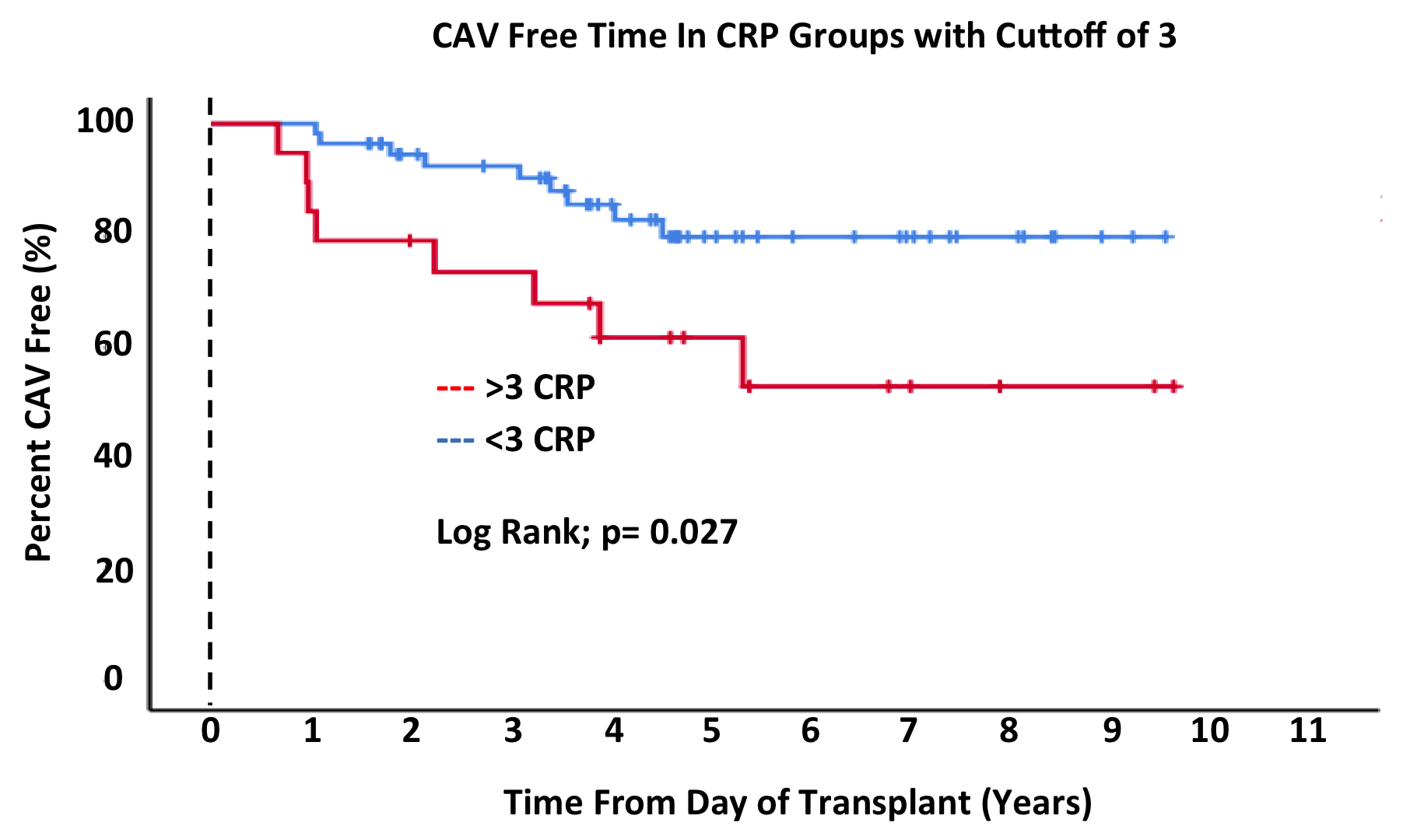C-Reactive Protein 1-Year Post-Transplant is Associated with Future Development of Coronary Artery Vasculopathy and Rejection in a Pediatric Heart Transplant Cohort
Congenital Heart Center/Pediatrics, University of Florida, Gainesville, FL
Meeting: 2020 American Transplant Congress
Abstract number: 79
Keywords: Heart transplant patients, Pediatric, Prognosis, Rejection
Session Information
Session Name: Heart Transplantation: Antibodies and More
Session Type: Oral Abstract Session
Date: Saturday, May 30, 2020
Session Time: 3:15pm-4:45pm
 Presentation Time: 4:03pm-4:15pm
Presentation Time: 4:03pm-4:15pm
Location: Virtual
*Purpose: Coronary artery vasculopathy (CAV) is one of the leading causes of mortality beyond 3y post-transplant (OHT). Multiple risk factors are associated with development of CAV. As there is contribution of innate immune system and systemic inflammation in development of CAV, we hypothesize that C-reactive protein levels as an indirect marker of systemic inflammation will predict future CAV development.
*Methods: We identified all pediatric patients who underwent OHT from 2004-2018 at our institution and collected pre-, intra-, and post-transplant variables hypothesized to have effects on development of CAV. We also collected CRP levels at 1-year post transplant +/- 1 months performed on routine clinical visits and prior to routine catheterizations. Cardiac catheterization data was also collected to determine the development of CAV. Data was analyzed using Mann-Whitney tests, chi-square with fisher exact, and Cox regression analysis.
*Results: We identified 111 patients with available CRP and catheterization data. Of these, 29.7% (n=33) had CAV, 8.1% (n=9) were re-transplants, and 49.5% (n=55) experienced acute cellular/humoral rejection by 1-year post-OHT. Median age of transplant was 11.7y (9.5, 16.5) in the CAV group and 7.1y (0.5, 13.3) in non-CAV group (p=0.010). Median age at CAV diagnosis was 17.1 y (12.8, 19.8) and median time to CAV development after OHT was 4 y (2.2, 8.5). Median CRP at 1 year was 1.1 mg/L (0.4, 2.7). Median CRP at 1 year in CAV group was 2.4 (1.5, 9) and 0.6 (0.2, 1.5) in non-CAV group (p=0.002). Median CRP in our no rejection group was 0.5 (0.2, 0.4) compared to 1.5 (1.5, 5.0) in group with history of rejection (p=0.014). Using a cut-off of 3 per previous adult studies, CAV-free time was significantly less in the patients with CRP >3 (log rank p=0.027; Figure). CAV was seen more commonly in re-transplants compared to primary OHT (66.7% v/s. 26.5%, p=0.019). In the CAV group, 90.9% had an episode of rejection compared to 59% in the non-CAV group (p<0.001). At the time of analysis CAV group had a higher mortality compared to non-CAV group (33% v/s. 11%, p=0.014; Odds Ratio: 3.83 [CI: 1.41-10.5]). Cox regression including variables associated with death indicated that CAV was independently associated with mortality (p=0.010).
*Conclusions: Median CRP at 1 year was associated with increased risk of CAV development and may serve as a predictive marker of CAV. Further research is required to assess the benefit of CRP levels early after transplantation on risk of development of CAV.
To cite this abstract in AMA style:
Tadros HJ, Bashir AH, Fricker FJ, Pietra BA, Gupta D. C-Reactive Protein 1-Year Post-Transplant is Associated with Future Development of Coronary Artery Vasculopathy and Rejection in a Pediatric Heart Transplant Cohort [abstract]. Am J Transplant. 2020; 20 (suppl 3). https://atcmeetingabstracts.com/abstract/c-reactive-protein-1-year-post-transplant-is-associated-with-future-development-of-coronary-artery-vasculopathy-and-rejection-in-a-pediatric-heart-transplant-cohort/. Accessed December 16, 2025.« Back to 2020 American Transplant Congress

